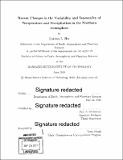Recent changes in the variability and seasonality of temperature and precipitation in the Northern Hemisphere
Author(s)
Hui, Katrina L
DownloadFull printable version (8.634Mb)
Other Contributors
Massachusetts Institute of Technology. Department of Earth, Atmospheric, and Planetary Sciences.
Advisor
Paul A. O'Gorman.
Terms of use
Metadata
Show full item recordAbstract
This study investigates recent changes in the variability and seasonality of temperature and precipitation in the Northern Hemisphere. The mean and variance of daily temperature and precipitation anomalies are calculated for each year over a 35-year period and compared to a base period. For temperature in the Northern Hemisphere, a noticeable warming trend amplified in the higher latitudes was observed, as well as a significant decrease in variability in the mid and high latitudes. For precipitation in the Northern Hemisphere, a drying trend and decreasing trend in variability were observed in the mid latitudes during summer. The seasonal cycles of both temperature and precipitation were also analyzed. The trends in temperature seasonal amplitude and phase were studied and revealed some influence of Arctic sea ice loss that changes the seasonality of local temperature, and Arctic amplification that potentially influences temperature seasonality in the mid and high latitude land regions. To determine whether the changes in temperature seasonality may affect temperature variance, analyses were performed by removing the phase trends from the temperature data using two methods. The phase trend-removed temperatures were found to have no prominent trends in variance. This suggests that changes in the temperature variance may be related to changes in temperature seasonality. To study what affects precipitation variability, the coefficient of variation (ratio of standard deviation to mean), which determines the shape of the mixed gamma probability distribution function (PDF) of precipitation, was studied. It was found that the mean and variance of precipitation have a fixed ratio over time, suggesting that the shape of the precipitation PDF has not changed. Therefore changes in the precipitation variance in the midlatitudes could be simply explained by the change in the mean precipitation in the same region.
Description
Thesis: S.B., Massachusetts Institute of Technology, Department of Earth, Atmospheric, and Planetary Sciences, 2016. Cataloged from PDF version of thesis. Includes bibliographical references (pages 59-60).
Date issued
2016Department
Massachusetts Institute of Technology. Department of Earth, Atmospheric, and Planetary SciencesPublisher
Massachusetts Institute of Technology
Keywords
Earth, Atmospheric, and Planetary Sciences.